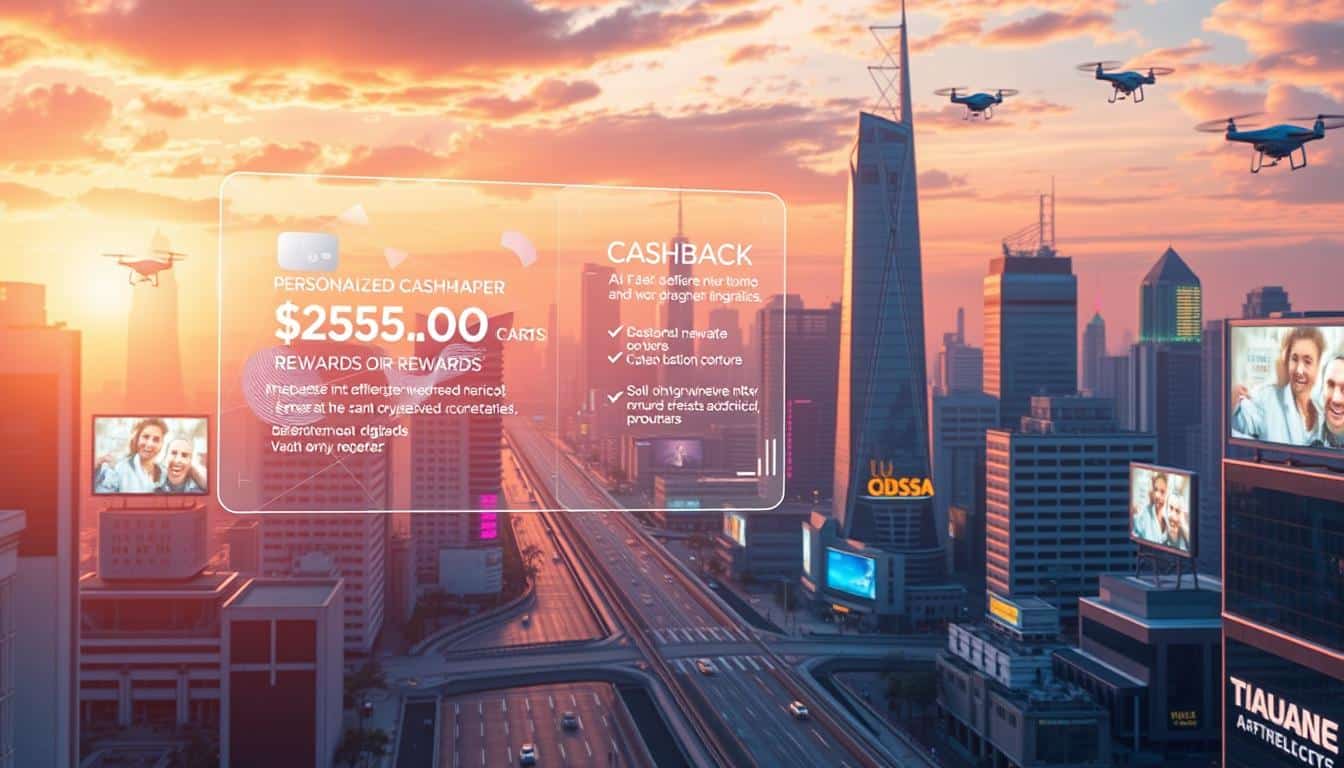The landscape of U.S. foreign trade is changing as 2025 approaches. Businesses face a challenging environment due to changing U.S. trade policies and global issues. This piece looks into key international trade insights for 2025, focusing on important data and trends for success in foreign markets.

TD Cash Back Visa Infinite* Card
Overview of U.S. Foreign Trade Landscape in 2025
The U.S. trade situation in 2025 looks complex due to various trade policies. Changes in international relations will make the trade scene shift, impacting the economy. Even though there may be growth, expect higher tariffs because of new policies affecting Mexico and Canada.
Anúncios
We need to grasp the factors shaping trade in 2025:
- Evolving Trade Agreements: Changes in agreements will impact exports and imports.
- Tariff Adjustments: Rising tariffs may limit trade and change market access.
- Regional Tensions: Political issues could affect trade stability.
This changing trade scene will significantly influence U.S. economic growth. It’s vital for those involved to adapt to stay competitive and promote sustainable trading in the future.

Key Trade Partners and Relationships
The United States has important trade ties with countries like Canada, Mexico, and China. These countries greatly influence how the U.S. trades. By 2025, new trade talks will change how goods and services move between these nations. The U.S.-Mexico-Canada Agreement (USMCA) is key, aiming for fair trade and handling tariffs.
Today’s tensions with China make it necessary to rethink the U.S. trade approach. The government is keen on protecting its interests, affecting global trade partnerships. With changing trade rules, companies need to stay quick on their feet.
Impact of Tariff Policies on Foreign Trade
In 2025, the U.S. is set to change its tariff policies. This will affect how countries trade with each other. The average tariff might be around 15%, but it could vary by country. These changes are crucial as they will lead to new trade hurdles. Businesses involved in global trade must understand these shifts to adapt successfully.
Current and Proposed Tariffs
New tariff rules could make trading with certain countries harder for businesses. Here’s a brief on the key points:
- Tariffs on Canada and Mexico can be as low as 3%.
- Tariffs on imported goods from China may reach up to 50%.
- Potential increases in tariffs could affect several sectors, including technology and agriculture.
Effects on Import and Export Dynamics
Tariff changes will greatly impact foreign trade. Here are possible outcomes:
- Imported goods may cost more, raising prices for consumers.
- Supply chains could see disruptions, affecting production time and costs.
- Trade relationships might change as countries react to the new U.S. tariffs.
Trends in Consumer Spending and Foreign Trade
In 2025, consumer spending patterns in the United States will change a lot. Higher tariffs and rising prices are expected to reduce spending. However, people will still buy nondurable goods, showing a change in what they prefer. This suggests that higher costs from tariffs may reduce how much people can buy.
These spending changes will greatly affect trade. As U.S. consumers change how they spend, the demand for imported goods will shift. This means changes to trade balances. As people rethink their spending for 2025, its impact on global trade will grow clear.
Emerging Strategic Sectors in Foreign Trade
By 2025, the face of foreign trade will change, influenced by new strategic areas. Investing in tech is now crucial for competitive industries. Semiconductors, artificial intelligence, and clean energy are expected to lead growth. This shift will open many doors for U.S. exporters, who must meet the changing global market demands.
Technological Innovations Impacting Trade
Technology is reshaping how businesses work and connect globally. Companies adopting new technologies will boost their efficiency and streamline their supply chains. For example, automation and big data analytics improve decision-making and cut costs. These changes help companies quickly meet market demands, strengthening their market position.
Regulatory Changes in Strategic Industries
As new trade technologies emerge, regulations will also change. It’s up to policymakers to make rules that back innovation but protect national interests. Fields like clean energy and AI might see new rules that encourage innovation and sustainability. It’s important for U.S. businesses to keep up and adapt to these changes to seize new opportunities.
The Role of the USMCA in Shaping Trade Dynamics
The impact of the USMCA will significantly change North American trade by 2025. This deal aims to make Canada, Mexico, and the United States closer economically. It hopes to make trading easier by lowering tariffs gradually.
The agreement isn’t just about tariffs though. It also talks about the environment and workers’ rights to ensure fair trade. By working together on these issues, the USMCA encourages a better way to do trade.
This shift will help all three countries grow economically. Businesses that trade across borders will see new chances to grow and work more efficiently. This shows why the USMCA is key to North America’s trade future.
Challenges in Global Supply Chains for 2025
The world’s supply chains are changing fast, mainly due to trade issues and recent global events. For companies to keep things running smoothly in 2025, they must grasp these challenges.
Effects of Recent Global Events on Trade
The COVID-19 pandemic and ongoing conflicts worldwide have shown how fragile global supply chains can be. This has led to higher costs, delays, and lots of uncertainty. Companies now face a tough time as natural disasters, political chaos, and different laws add to the chaos. They must be agile and plan carefully to navigate these uncertain times.
Nearshoring and its Benefits
Seeing these obstacles, many firms are looking at nearshoring to make their supply chains stronger. Moving production closer to their main markets helps lessen global supply chain risks. This approach cuts shipping costs and boosts reaction to market changes. Nearshoring makes for stronger, more flexible trade ties, helping companies handle the aftermath of recent events better.
Inflation and Its Influence on Foreign Trade
Inflation is expected to greatly affect international trade in 2025. Businesses will face challenges due to higher costs in many areas. This situation, known as foreign trade inflation, will change how companies price goods and spend money, affecting their profits.
Higher tariffs and pricier goods are making inflation worse. This forces a rethink of how economic influence on trade works. For companies in international trade, adapting to these changes is key. If they don’t, they might fall behind in the worldwide market.
It’s vital for businesses to tweak their pricing and predict how customers will react. By understanding foreign trade inflation and economic trends, companies can stay competitive in a changing world.
Impact of Protectionism on Foreign Trade
Protectionism is changing how countries trade with each other. Nations worldwide are adjusting their policies due to the U.S.’s new trade measures. This has caused a big shift in global trade.
Global Responses to U.S. Trade Policies
Other countries are fighting back against U.S. trade policies. This has led to higher trade tensions. Countries are setting up tariffs and barriers in reply. Highlights include:
- Putting tariffs on goods from the U.S.
- Boosting local industries to depend less on U.S. products.
- Looking for new trade deals with other countries.
The U.S. needs to talk more with its trading partners. Working through these trade issues and encouraging teamwork could help stabilize global trade.
Technological Developments in Trade Compliance
In 2025, new tech will play a big role in helping businesses with international trade. Companies will use artificial intelligence and machine learning to follow changing rules better. These tools will make things simpler, cut down on mistakes, and improve how things work.
As more companies use regulatory tech, they will be ready for changes in rules and actions by regulators. They’ll use advanced data analytics to look through a lot of info quickly. This will help find risks faster. It’s a way to work better and make sure everyone is responsible.
Businesses will also get help from automated systems that keep an eye on rules in real-time. This move to automation changes how companies handle compliance. It helps them stay flexible when things change fast. Being efficient in following rules is very important. It helps companies stay ahead while avoiding risks from not following the rules.
Foreign Trade Compliance Trends in 2025
In 2025, the world of foreign trade compliance will see big changes. These changes will come from new trade rules and more watchful authorities. Companies will need to step up their compliance games to face these changes head-on. To avoid risks linked to breaking the rules, being ready for these changes is key.
Companies will face tougher punishments for breaking trade rules, showing a strong drive to keep up global trade standards. They need to make sure their internal processes match the new rules. This way, they can avoid big fines and problems that slow down their work.
- Regularly update compliance frameworks to reflect new trade regulation updates.
- Invest in training programs for staff to stay informed about compliance trends.
- Implement advanced technology solutions to streamline compliance processes.
As the compliance world changes in 2025, staying ahead is a must for businesses. Knowing and understanding these trends will help them deal with the challenges of foreign trade better.
Recommendations for Businesses Engaging in Foreign Trade
In 2025, businesses will find foreign trade more complex. It’s important to have solid strategies for success. Being proactive about trade policy can really help a business stay strong and competitive. It’s also crucial to keep up with rules and market changes to avoid surprises.
Maintaining Vigilance on Policy Changes
It’s key for companies working internationally to stay updated on trade policy changes. They should:
- Regularly review updates from trade authorities and government bodies.
- Work with industry groups to get and share important insights and strategies.
- Make sure teams know about compliance and best practices.
Diversifying Markets and Supply Chains
Finding new markets and having diverse suppliers can make a business more stable. Businesses should:
- Look for up-and-coming markets with opportunities for growth.
- Develop relationships with various suppliers to avoid problems if one has issues.
- Use new technologies to make supply chain processes better.
Conclusion
The 2025 U.S. trade report shows a complicated picture. It’s shaped by new tariff rules, changing what customers want, and stricter rules to follow. Companies need to really understand how outside things like inflation and protectionism affect them. This will help them make good plans.
Looking ahead, what the 2025 trade will be like depends on working well with others worldwide and always checking the market. Companies that spread out their markets and supply chains will do better facing new problems. Having a good strategy and watching for policy changes is key to doing well in foreign trade.
To wrap up, U.S. foreign trade is always changing and needs constant watching and smart planning. By focusing on following rules and being innovative, companies can avoid risks and take advantage of new chances. Embracing these ideas is crucial for doing well in U.S. trade’s uncertain future.
FAQ
What factors are influencing U.S. foreign trade in 2025?
How will tariffs affect trade relationships in 2025?
What are the expected trends in consumer spending in 2025?
What strategic sectors are expected to emerge in U.S. foreign trade?
How will the USMCA affect U.S. trade relations with Canada and Mexico?
What challenges do global supply chains face as we approach 2025?
What impact could inflation have on foreign trade?
How are global responses to U.S. protectionist policies shaping trade dynamics?
What advancements are being made in trade compliance technology?
How can businesses prepare for changes in foreign trade compliance in 2025?
Conteúdo criado com auxílio de Inteligência Artificial



